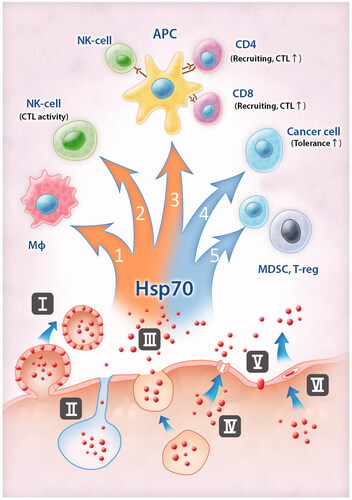Figures & data
Figure 1. Pathways of Hsp70 release from cancer cells and consequences of this exodus for anti-tumour immunity. Hsp70 is able to leave cells using different ‘doors’: inside exosomes and on their membrane (I), with lysosomes (II), using secretory-like pathways (III); Hsp70 could form channels (IV), penetrate through the lipid bilayer (V), or the structure of lipid rafts (VI). When Hsp70 appears outside the cancer cell it modulates anti-tumour immunity in different ways. It triggers (red arrows on the left) anti-tumour immunity through activation of pro-inflammatory cytokine expression (1) and CTL-response. Exogenous Hsp70 can trigger CTL-activity directly (2) or through interaction with APC, mediation of cross-presentation, CTL-programming, DC-licensing and NK-DC cross-talk (3). Immunosuppressive properties of Hsp70 (blue arrows on the right) are associated with enhancement of tolerance of cancer cells (4) and activation of cells with immunosuppressive functions (5).

Table I. Immunotherapeutic effect of antitumour therapy based on Hsp70.
